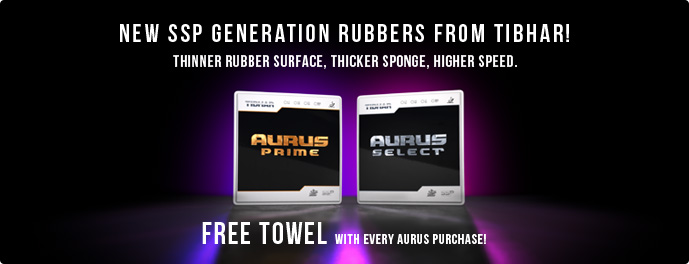Rubber Blind Test Part 1 of 3: Tibhar Aurus Prime and Aurus Select
20 July 2017 | Posted in: Table Tennis Reviews
About the Reviewer
 Patrick Hrdlicka is a table tennis enthusiast, who was introduced to the sport by his parents at the age of six. Patrick progressed to play in the highest national cadet and junior team leagues in his native Denmark and was among the top 40 players in his age group, which fostered several long-standing members of the Danish National Team. With college looming, Patrick quit the sport for almost twenty years. During this hiatus, he obtained a Ph.D.-degree in chemistry and accepted a position as professor of chemistry at the University of Idaho.
Patrick Hrdlicka is a table tennis enthusiast, who was introduced to the sport by his parents at the age of six. Patrick progressed to play in the highest national cadet and junior team leagues in his native Denmark and was among the top 40 players in his age group, which fostered several long-standing members of the Danish National Team. With college looming, Patrick quit the sport for almost twenty years. During this hiatus, he obtained a Ph.D.-degree in chemistry and accepted a position as professor of chemistry at the University of Idaho.
At the beginning of 2014, the mid-life crisis and yearning for table tennis grew too strong for Patrick and he decided to pick up the sport again. Bitten again by the table tennis bug, he plays 4-6 times per week.
Since his comeback to table tennis, he has enjoyed combining his analytical and experimental skills with his love for table tennis, testing and reviewing a wide range of table tennis equipment.
Introduction
A couple of weeks ago, the guys from Tabletennis11.com asked me if I was interested in conducting a blind-test of four rubbers. I was not given any information or hints regarding the nature of these rubbers but I assumed that they would be new or upcoming offerings. Intrigued by the challenge, I accepted. This post is the first of the three to be released in this series.
Testing procedure
I evaluated the four brand-new and unboosted test rubbers using an OFF- rated 5-ply all-wood blade with a classic limba/limba/ayous/limba/limba ply construction and Spinlord Waran short pips in my backhand. I attached the test rubbers (TRs) using three layers of Revolution 3 normal viscosity glue and evaluated them in the following order over two sessions using seamless 3-star 40+ plastic balls: TR1, TR3, TR2, and TR4. After ~15 min of warmup, I played practice matches against my usual training partners. Before embarking on the tests, I played one session with Tibhar’s Evolution MX-P in my FH to get used to non-Chinese rubbers again as I have been playing with DHS’ Hurricane 8 in my FH for the past ~3 months.
Test rubber #1 – A fast catapult machine.
Physical appearance: The topsheet is very thin, matte, non-tacky but very grippy. As far as I can tell, the pips are thin and small. The sponge has a dark purple color, prominent sweet booster smell, high density of small pores, and is medium hard (~47 degrees). The test sheet, which showed no signs of doming, weighed 47 g when cut to a 157x150 mm blade.
Playing impressions: Right from the get-go, it became obvious that TR1 is a fast rubber with a very prominent catapult, which makes it feel even faster than Tibhar’s Evolution MX-P. The feeling on FH drives is very direct and almost speed-glue like, with plenty of power reserves for play from mid-distance and beyond. The rubber feels like a ~48 degree rubber on these shots. Medium paced FH loops have medium-high trajectories with plenty of clearance over the net and land deep in your opponents’ territory. On one or two occasions, I hit through the sponge against heavy backspin balls, which resulted in uncontrolled ball trajectories, but the control on loops and loop-drives is - all in all - excellent. The rubber does most of the work of the work for you, allowing you to use compact strokes. Slower loops can be loaded with spin, affording spin levels like Chinese rubbers on equivalent shots. High-impact loop-drives are much faster but less spinny than equivalent loop-drives performed using Chinese rubbers such as the DHS Hurricane 8. Flat hits and smashes are a delight with this set-up – fast, deadly, yet controlled, a quality which reminded me of Tibhar’s Evolution MX-P. Blocking is direct and controlled with the TR1, as the low spin sensitivity renders it very easy to precisely redirect the shot in the direction of choice. The prominent catapult rendered FH pushes challenging, as they had a tendency to pop up and go long. I had better control on BH pushes, which could be produced with vicious amounts of spin and kept flat over the table. Aggressive serve returns felt very controlled, especially since the topsheet is not particularly sensitive to incoming spin. Judging by the returns of my practice partners, I was able to serve with high amounts of spin. I found it easy to control the placement of my serves with TR1.
Conclusion: Test rubber #1 reminds me of a faster, slightly spinnier, and more direct version of Nittaku’s Fastarc G1. It is at least as fast as Tibhar’s Evolution MX-P while having a higher throw and producing slightly less spin. No question: this is a rubber that is designed for high-level players with a modern aggressive game style. If I were to play with non-tacky FH rubbers again, TR1 would be among my top 3 choices along with MX-P and MX-S. In addition to the potential weaknesses in the short game, I am concerned how TR1 will play once the booster effect wears off – will it feel mushy or maintain its crisp feeling? This is a very fast rubber, and I would be hesitant to combine it with faster blades. In fact, I think even advanced players could use TR1 with an ALL+ blade. This is definitively not a beginner’s rubber!
Patrick’s guess: It feels like a Tibhar rubber - Tibhar Aurus Prime?
Rubber identity: Tibhar Aurus Prime
Serves: 9/10
Serve receives and short game: 8/10
Looping: 9/10
Flat hitting: 9.5/10
Blocking: 9.5/10
Read Tibhar Aurus Prime Customer Reviews & Get Our Best Price >>
Test rubber 3 – A looping machine
Physical appearance: Just like TR1, the topsheet of TR3 is very thin, matte, and non-tacky yet very grippy. As far as I can tell, the pips are thin and small. The sponge is rose-colored, and has a prominent sweet booster smell, high density of small pores, and is medium-soft (~42 degrees). The sponge side curls slightly up. The test sheet weighed 45 g when cut to a 157x150 mm blade.
Playing impressions: TR3 shares many of the characteristics of TR1 but is slightly slower, less spinny, and easier to control. It gives a direct feeling and prominent sound on FH drives but with a less pronounced catapult. FH loops have a medium-high arc over the net but dip down faster than with TR1 due to the lower inherent speed of the rubber. In general, I felt that I had more control on loop-drives than with TR1, but they also seemed to be less spinny. FH-to-FH topspin rallies from mid-distance were fun to play, but TR3 does not have the power reserves of TR1 to allow for effective play from beyond mid-distance without significant effort. Occasionally, I had difficulties getting the bat angle right on FH loops against very high backspin, with the ball going long (rather than into the net). Interestingly, the rubber feels harder in game play (~45 degrees) than it does to the touch (~42 degrees). Just like with TR1, blocking and flat hits were easy to execute with this rubber, albeit being slightly slower and more controllable. I had a much easier time doing FH pushes and touch shots with TR3 than with TR1, probably because the catapult is less pronounced. Aggressive serve returns were easy to do as the rubber does not seem to be particularly spin sensitive. I found it difficult to produce very high levels of spin on my serves, but serve placement was excellent.
Conclusion: All-in-all this is a nice, controlled, and forgiving rubber for the loop-oriented player, which also has a lot of potential as a BH looping rubber due to its softer nature. However, I found myself longing for higher spin values on high impact shots. The closest parallel that I can think of for TR3 is a less spinny version of Tibhar’s Evolution EL-S or Xiom’s Omega V Tour. Due to its controlled and forgiving nature, I could see a broad base of players use this rubber, including intermediate and advanced players, as well as kids.
Patrick’s guess: This feels like a softer and more controlled version of TR1 and consistent with my guess for TR1, I will say Tibhar Aurus Select.
Rubber identity: Tibhar Aurus Select
Serves: 9/10
Serve receives and short game: 9/10
Looping: 9.5/10
Flat hitting: 9/10
Blocking: 9/10
Get Our Best Price for Tibhar Aurus Select >>
OTHER ARTICLES OF THE SERIES:
Rubber Blind Test Part 2 of 3: Nittaku Hammond Power
Rubber Blind Test Part 3 of 3: Neottec Katana

